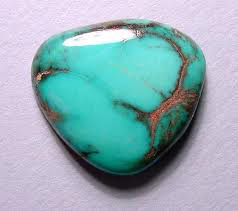Jewelry Info

Turquoise
We sometimes hear someone remark that turquoise jewelry is a "fad", or that they don't wear "Indian jewelry."Well, if turquoise is a fad, it's got to be the longest running trend ever, as history records its popularity over 7,000 years ago! Archaeologists have recorded that the oldest known piece of jewelry is a gold and turquoise bracelet found on the arm of a mummified Egyptian Queen, around 5000 B.C.
The area once known as Persia, today's Iran, has been producing gem quality turquoise for centuries, as has China.
Native Americans have worked the stone since before the time of Christ. When the Navajo, Hopi, and Pueblo people learned silversmithing from the Spaniards in the 1800's, the stone was incorporated into their pieces. This jewelry was the precursor to the work we identify today as Indian jewelry.
Cerrillos, New Mexico is thought to be the location of the oldest turquoise mines in the country. Prior to the 1920's, the state was the country's largest producer; it is more or less exhausted today.
Arizona currently produces the most turquoise of value domestically. There are many other mines throughout the Southwest, many of which have been exhausted.
Turquoise is made up of phosphorus, copper, and aluminum. The copper is the mineral responsible for the identifying robin's egg blue color that is so valued in the stone.
The mother rock, or matrix, can often be seen running throughout the stone in a network pattern, adding interest and enhancing the beauty of the turquoise.
Most turquoise on the market today has had some kind of treatment to enhance or stabilize the stone. These procedures reduce the value of the stone in varying degrees.
Only about six percent of stones today are what we call "natural turquoise". These have not been altered in any way from their natural state. Stabilizing the turquoise is accomplished by impregnating the stone with an epoxy-type substance to make it more durable.
It is important when purchasing turquoise jewelry that the salesperson is able to indicate if the piece has been treated, or is natural.
Being a phosphate mineral, turquoise is inherently fragile and sensitive to solvents; perfume and other cosmetics will attack the finish and may alter the color of turquoise gems, as will skin oils and most commercial jewelry cleaning fluids. Prolonged exposure to direct sunlight may discolor or dehydrate turquoise. Care should be taken when wearing such jewels. Cosmetics, sunscreen, and hair spray should be applied before putting on turquoise jewelry.
After use, turquoise should be gently cleaned with a soft cloth to avoid a build up of residue, and should be stored in its own container to avoid being scratched by harder gems. Turquoise can also be adversely affected if stored in an airtight container-it likes to breathe.
click thumbnail for larger view
Hand made of high karat gold in Santa Fe, New Mexico
Please Contact us for more information.
Due to the fluctuating price of gold, prices may change without notice.


